#1896 Ephemera
Explore tagged Tumblr posts
Text
1896
THE GENTLEWOMAN. October 3 & 17
Darmstadt, October 3
The Grand Duke and Duchess of Hesse intend to move with their Court from the Jagdschloss Wolfsgarten to the New Palace at Darmstadt, on Tuesday, the 6th int., in order to be there at the arrival of the Tsar and Tsaretsa.
The Grand Duke and Duchess Serge of Russia arrived at Darmstadt from Venice last Wednesday, and went immediately to Wolfsgarten.
The Princess Louis of Battenberg is now at Heiligenberg with their children, and pays frequent visits to the Grand Duke and Duchess.
Little Princess Elizabeth is already talking about her cousin, Grand Duchess Olga, and is delighted that she is soon to have a little companion to play with. Her Grand Ducal Highness is a very pretty, clever child, and remarkably lively.

Darmstadt, October 17
The little Princess Elizabeth of Hesse is delighted with her still smaller cousin, Grand Duchess Olga, and to see the babies playing together is an unfailing source of delight to the two young mothers. Both are very pretty children, and are extremely forward for their age.
(...)
On Tuesday last the Grand Duke and Duchess drove with their Imperial guests to Heiligenberg, where they had tea with the Princess Louis of Battenberg; and the next afternoon was spent at Jagdschloss Wolfsgarten, where they also had tea, and returned in the evening to Darmstadt.
source: the British Newspaper Archive
image: Hessian State Archives, Elisabeth and Olga sit on their mothers' laps and pose in a group picture taken in June 1896.
16 notes
·
View notes
Text

La Belle Jardiniere – January, 1896
Artist: Eugène Grasset
#reddit#art nouveau#deleted user#1845-1917#1896#1890s#1800s#january#la belle jardiniere#eugène grasset#1900s#calendar#art#artist#shovel#snow#ice#frozen#fountain#ephemera#french#france
19 notes
·
View notes
Text

Greetings from Bremen, Germany
German vintage postcard, mailed in 1896
#postal#german#historic#ansichtskarte#sepia#vintage#tarjeta#germany#briefkaart#photo#bremen#mailed#greetings#postkaart#ephemera#postcard#1896#postkarte#photography#carte postale
8 notes
·
View notes
Text
Gallery visit: MCA Tacita Dean exhibition PART 1 (13.12.23)
Context: Tacita Dean is an artist who reflects on nuances and transformations that exist in memory, impermanence/mortality, time, and the natural environment. She articulates these themes through her approaches to celluloid film, photography, drawing, printmaking and installation.
My Reflection: I was intrigued by the approaches Dean took in the production of her works, particularly of her films and drawings (composition, colour/light, tactility/texture, sound, etc.). I noticed an overarching theme of 'the archive', alongside the other themes (mortality, nature, memory, spirituality, etc.).
In the presentation of her works, elements of theatricality and transformation respond to and connect these themes together. However, they are grounded by personal narratives within the work (which can either be read by audience as Dean's (the artist) experiences or as their own).
Buon Fresco (2014, silent short film (16mm, 33 mins) - screencaps below)

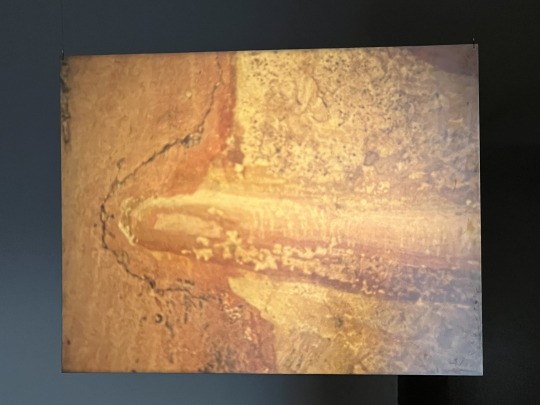
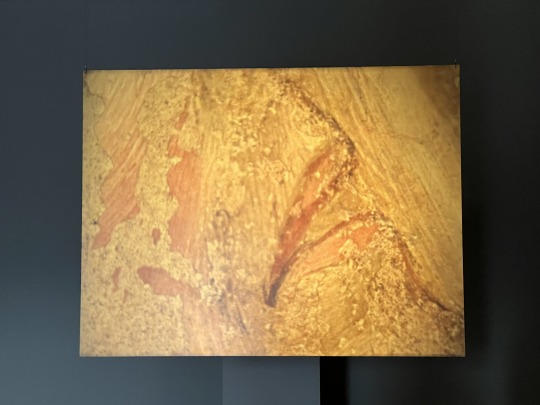
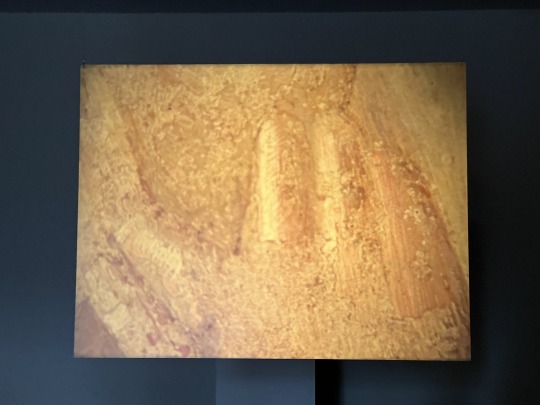
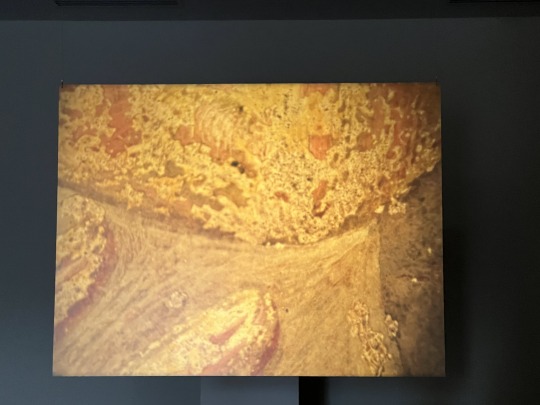
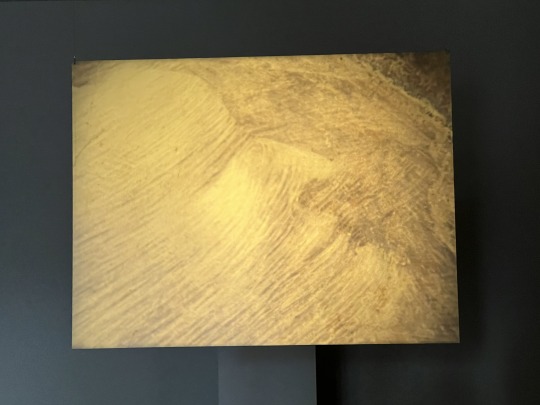
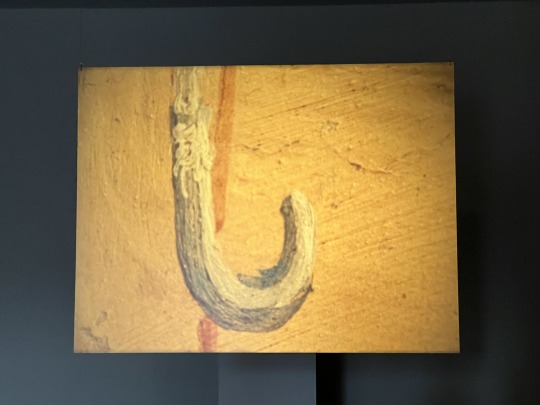
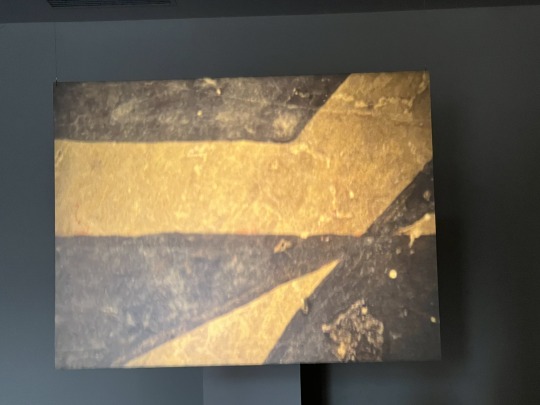
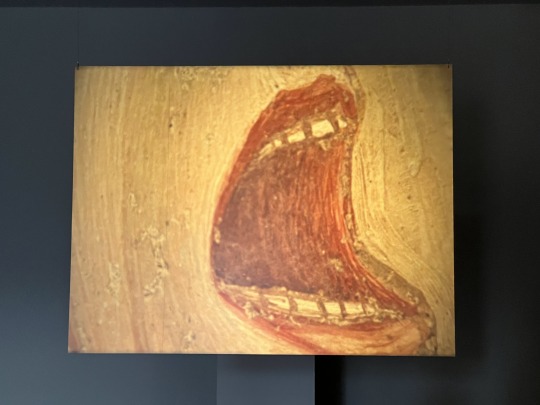
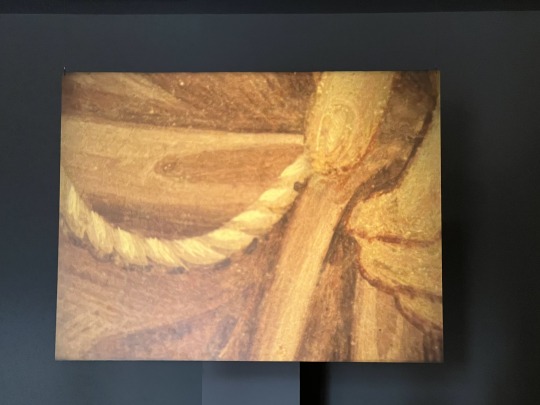
Description: "The film Buon Fresco (2014), back-projected on a free-floating screen, observes in close detail 13th-century frescos, The Life of St Francis (1296) by painter Giotto di Bondone (b. c.1267 – d. 1337) in the Upper Basilica of St Francis of Assisi, Italy. Filmed using a macro lens and with a scissor lift, Tacita Dean captures the extraordinary frescos at very close quarters, attaining the unique viewpoint of the painter himself. Buon Fresco allows the visitor to examine the fine detailing of Giotto’s work – such as individual brushstrokes, the texture of clothing and the artist’s ‘pentimenti’ or mistakes – that would otherwise be concealed to someone standing on the ground.
The film is a reflection of Dean’s fascination with the story of St Francis, a man who became a saint at the same historical moment that Giotto’s painting marked a transition in western art history from the flat style of the Byzantine icon to the naturalism of the Renaissance. It also points to Dean’s ongoing conversation with artists from history which is revealed in her film portraits."
Monet Hates Me (2021, multimedia installation featuring a box, one edition of 100, each containing 50 objects (not all photographed) - some from the Getty Research Institute's Special Collections and others made by Tacita Dean and Martyn Ridgewell - including a record player showcased in the video below)
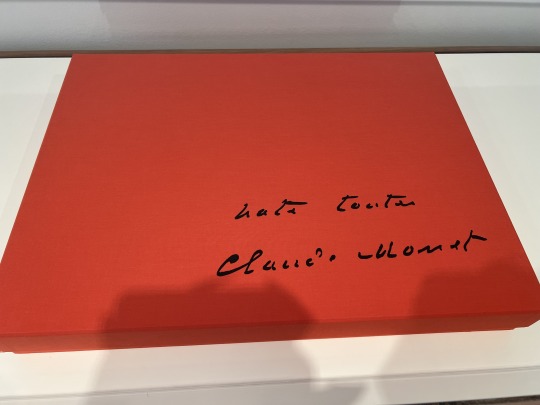
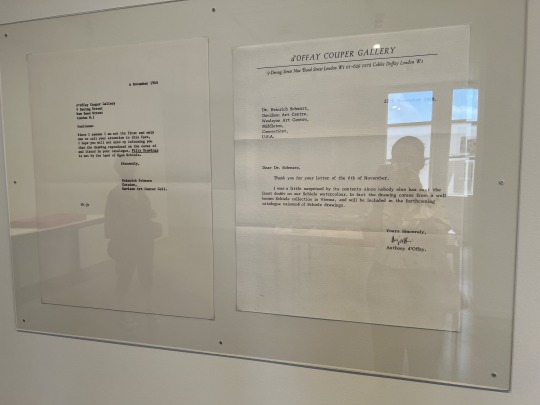

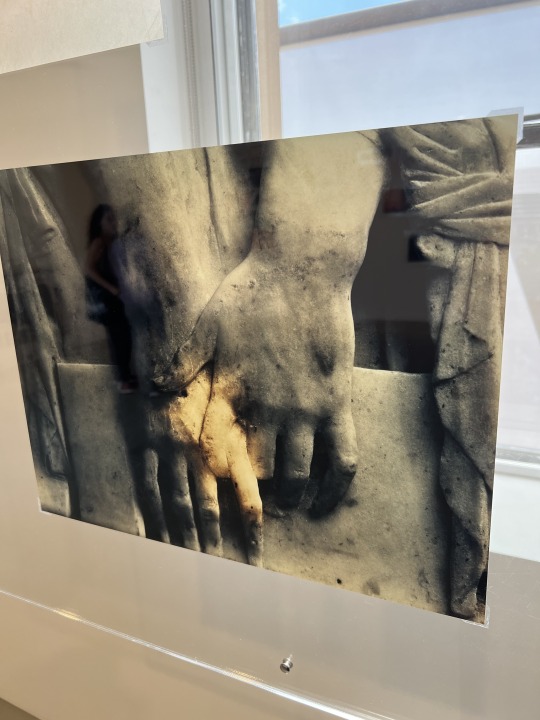
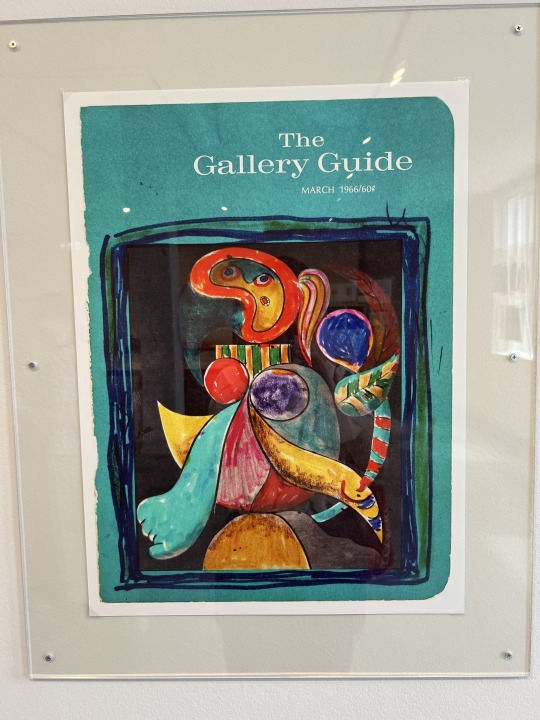
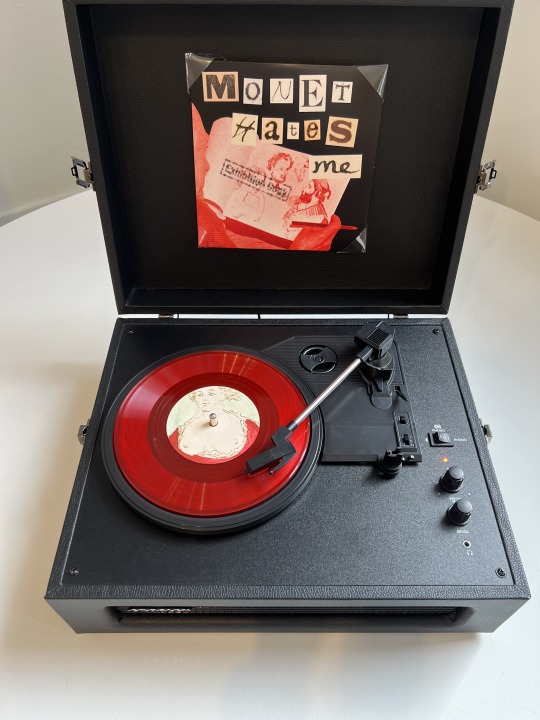
Description: "Tacita Dean has spoken about her reliance on ‘objective chance’ in her approach to art making. The term is borrowed from the French ‘hasard objectif’ coined by French surrealist poet André Breton (b. 1896 – d. 1966) and refers to a process that allows the connection of seemingly unrelated images, objects and events. Like the surrealists, Dean’s artistic process is driven by chance encounters, spontaneity and a willingness to embrace unexpected outcomes.
Monet Hates Me (2021) is an edition of 100 clothbound boxes, each containing 50 objects. The project developed when Dean was invited to be an Artist in Residence at the Getty Research Institute in Los Angeles, where she allowed chance to guide her research.
Following a process of random selection – at times literally pointing to boxes on shelves – Dean explored the Getty’s vast repository of objects and ephemera. Monet Hates Me combines objects drawing on items found in the Special Collections alongside newly created works, meticulously designed and produced by the artist and her collaborator, Martyn Ridgewell, during prolonged periods of lockdown due to the COVID-19 pandemic.
Conceived as ‘an exhibition in a box’, Monet Hates Me has a domestic scale. It evokes the spirit of the boîtes-en-valise (literally, an exhibition in a suitcase) by French artist Marcel Duchamp (b. 1887 – d. 1968) and the dreamlike worlds created by the American artist Joseph Cornell (b. 1903 – d. 1972). Dean’s work is a playful conversation with the history of art and its artists, inviting reflection on questions of authenticity and intention, originality and its doubling, and the role of the hand-made and the mechanically reproduced in the digital age."
Claes Oldenburg draws Blueberry Pie (2023, silent short film (16mm, 20 mins) - screencaps below)




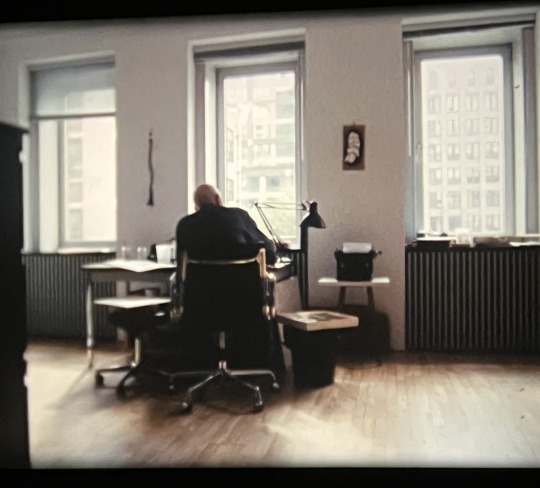


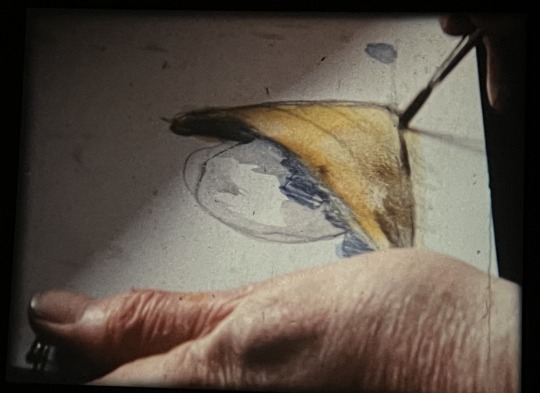
Description: "Tacita Dean’s new film, Claes Oldenburg draws Blueberry Pie (2023), depicts the American Pop artist Claes Oldenburg (b. 1929 – d. 2022) drawing in his Manhattan studio. Oldenburg, in Dean’s words, was a ‘virtuoso draughtsman‘ who drew ‘fluid, wry, brilliant, funny‘ images that often referenced his giant public sculptures.
The footage is from October 2010, when Dean filmed Oldenburg over the course of a day in his Broome Street building in New York. Oldenburg drew in the morning and, in the afternoon in his basement, dusted and arranged an accumulation of objects that he had collected or been given following the presentation of his work Mouse Museum (1965–1977).
Dean initially disavowed the footage of Oldenburg drawing, thinking it had done the artist a ‘disservice‘ and turned a ‘self-absorbing act into a self-concious exercise‘. She chose to make the film of Oldenburg arranging his bric-à-brac instead, which Oldenburg himself titled Manhattan Mouse Museum (2011). After Oldenburg passed away in 2022, Dean rewatched the unused rushes of the shoot – something she never does – and discovered something new.
Reflecting on the footage, Dean writes: 'With twelve years distance, I can see what Claes has given me. We are all different: one artist’s self-consciousness is another’s self-awareness ... Claes knew what he was doing. Of course he did. And now it’s over to me again.'"
0 notes
Link
Check out this listing I just added to my Poshmark closet: Vintage Varga Pin-up Girl Jester Image Pendant with Tiny Pink Pearls & Silver.
0 notes
Note
Go on intrigue me……what is your postcard collection like? How many do you have and of what subjects?
Thank you so much for your question!
For context, I became interested in OTMA in late 2019, but didn't even known these postcards existed until 2021! I remember seeing a newspaper article about OTMA selling on ebay and being amazed haha. I personally don't follow any other royal families other than the Romanovs, so I had no idea there was so much cool ephemera floating around on the internet.
I started collecting postcards in October 2021, my first card was this lovely one of Olga! It has a little tear/crease in the corner but I don't mind, it's special to me nonetheless :)

The last time I counted, I have 55-ish postcards, ranging from 1896 - around 1920s. About 40 of those are specifically NAOTMAA related. The others are of extended family I find interesting like Astrid of Sweden and Ella of Hesse (though cards of Ella rarely crop up), and a couple are from the 1910s of some Edwardian actresses for a YouTube video I was making on the topic.
The first things I collected weren't postcards, but actually the Guerin-Boutron chocolate cards (still missing the second Tatiana unfortunately) and some old newspaper sheets. The paper on the right has mixed up baby Alexei with baby Anastasia lol. I'm very fond of the chocolate cards, they are gold and shiny!



These postcards are so precious to me and I just love checking the post to see if any have turned up! I keep them in a little box that I painted with OTMA's initials on and in a postcard album, but my two favourite cards are in a little golden frame to the side of my desk, so I have Olga and Tatiana motivating me when I work xD
I also love reading the backs of the postcards. Some are really hard to read, and some are in French/Russian/German which is beyond me, but the English ones are so interesting to me. A couple talk about the weather, holidays, and their family, which is a lovely insight into 1900s British social culture.
9 notes
·
View notes
Text
THE HISTORY OF CRISPIN GLOVER’S BIZARRE DEBUT ALBUM
POSTED BY WITNEY SEIBOLD ON SEPTEMBER 20, 2017 VIA NERDIST.COM
Actor, artist, and lovable weirdo Crispin Glover first caught the public’s eye in 1984’s Friday the 13th: The Final Chapter, when he did a spasmodic dance to Lion’s “Love is a Lie.” The next year, he was George McFly in Back to the Future, the highest-grossing film of its year, and deeply entrenched within the geek canon. He also retained a good deal of street cred by appearing in River’s Edge, the film to win Best Picture at the Independent Spirit Awards in 1986. It wouldn’t be until 1989 that Glover would return to film. It was during this very brief hiatus that Glover, perhaps possessed by the muses, decided to explore his capacity for writing books and performing music.
For many young, upcoming stars, this is a rite of passage. Remember when Lindsay Lohan released two studio albums? Hailee Steinfeld is currently finding her feet as a pop sensation. Crispin Hellion Glover, however, wasn’t concerned as much with pop, and is not known for his dulcet singing voice. Even at the time, Glover was known for being a jittery weirdo; many may remember his infamous appearance on Late Night with David Letterman when he appeared as his fictional character Rubin Farr, answering every question with a non-sequitur. Rubin Farr was to eventually appear in 1991’s Rubin and Ed. In 1987, it made no sense.
So of course, Glover’s studio album debut was one off the most oblique, abstruse pieces of pop ephemera to come out in the ’80s. In 1988, Glover recorded and released THE BIG PROBLEM ≠ the solution. The Solution = LET IT BE. (complete with that punctuation), which is, to date, his only record. I own it on CD. Yes, it’s every bit as strange as one can imagine.
THE BIG PROBLEM, released by Restless Records, is a 13-track concept record that includes a few singles stand-alone songs, and multiple readings of strangely worded poetry set to dreamlike, atonal electronic or accordion music. Glover hooked up with famed novelty musicians Barnes & Barnes (Bill Mumy and Robert Haimer), who performed and recorded all the album’s music. Well, almost all the music. One of the accordion tracks,“Selected Readings from OAK MOT, part III” featured “Weird Al” Yankovic, who’s credited for a wild accordion solo. But fans of Barnes & Barnes likely hear the duo’s influence all over the record. It has the same sexually frustrated, echoey, strained vocal quality as the best of Barnes, and the same willfully simplistic, near-emetic tone. Glover and Barnes were a great pairing, and they amplified each other’s strangeness.
THE BIG PROBLEM was part of a larger multimedia art project that also incorporated two art books that Glover published that same year. Both books, Oak Mot and Rat Catching, were disturbing books of impenetrable poetry which repurposed existing books into nightmarish photo collages; Rat Catching was more or less an 1896 textbook that he re-drew page by page. Unsurprisingly, images from Rat Catching appear in the opening title sequence of the 2003 remake of Willard starring Glover. Glover toured with the books, giving live readings that were accompanied by slide shows and selected tracks from his album.
The album’s poetry readings are hypnotic, but the songs are outright comedic. There’s a rap about masturbating (“Auto-Manipulator”), a wonderful, wonderful, screeching, crying rendition of “These Boots Are Made for Walking,” and the big hit, a song about a clown called “Clowny Clown Clown.” Part of that track was featured on David Letterman until the annoyed host cut it short. The video, as you’ll see, also features Rubin Farr, whose photograph is in the record’s liner notes.
THE BIG PROBLEM feels like a prank, something that should not have been allowed to happen. There are no hints to its intentions, and no solutions to the titular problem. Well, that’s not entirely true. There was a hint. On the back of the album, Glover slipped in the inscription “All words and music point to THE BIG PROBLEM. The solution lay within the title; LET IT BE. Crispin Hellion Glover wants to know what you think these nine things have in common.” He left a telephone number so you could call up and give your own theories: (213) 464-5053. I called it, but it’s been disconnected. I’d love to know what was on that tape.
What do you think? I have no hotline, but I’d love to hear your theories.
12 notes
·
View notes
Text
Sword and Pen Reread, chapter 12
Juicy, juicy Khalila/Dario stuff here. But my focus remains on Morgan, Wolfe, Santi, and worldbuilding. Really.
Some foreshadowing of Nobel’s device in the ephemera. Only the Archivist gets to control it, not even the Lord Commander - that’s going to be a problem later. It’s a threat, but one he says they would never plan to actually use. Parallels with nuclear weapons, I think.
Nobel says that the French rebellion inspired him to think of this. Nobel lived from 1833-1896, so that gives us a possible range of dates for when things started getting bad in France. Obviously that wasn’t the end of it, since we have indications that the ex-Archivist was involved in bad shit in France, too. France has potentially been a mess for almost 200 years.
@thegreatlibraryfangirl, I want to see you pick this stuff apart. So much good K/D.
Dario is an absolute wreck here. Desperate, needy, craving affection, struggling not to cry. The betrayal mission really hurt him. Is it just that? Or is this piled on weight from the other betrayals too?
That “No, let’s not talk about what happened, let’s talk about getting married” transition. Dario is convinced he’s a terrible person, and he wants commitment from Khalila as reassurance that even though he’s horrible, she won’t leave him.
This is about the third time Dario has proposed. He doesn’t think Khalila has taken him seriously yet - how many off-page conversations on this topic are we missing?
More Khalila-Morgan parallels: taking care of their reckless found family and partners. This time, it’s Khalila trying to get Dario to eat and rest.
Dario has “wavy black hair”. All I’m saying is that it’s very possible that it’s wavy when short but would grow out into curls.
“Are you suggesting that I am not a gentleman?” “Never. But you certainly pretend not to be one to everyone else.” This isn’t just about Dario making sexual advances. This is Khalila reassuring Dario that she knows he’s a good person, which he really needs.
Dario questions whether the terrible things they do are worth it. Khalila assures him that they have to be. This seems like it will be relevant later when thinking about how they process the stabbing and Morgan’s death.
Thanks to Maz, I now know that stormy weather in Alexandria is normal for winter. More support for my timeline speculation that it’s November-ish, yay.
Murasaki is worried about the Archives. She would know about Nobel’s device by now. She wants an alternative. She puts Khalila to work contacting the Curia to find solutions. This is where Khalila and Morgan start scheming to copy the Archives, I suspect - Eskander has already been shot by this point, so Morgan is taking on more responsibilities in the Iron Tower. Who’s answering messages directed to the Obscurist Magnus? Eskander or Morgan?
Murasaki is willing to consider printing, but she also teases Khalila about being a heretic. She’s a drastic improvement over the old Archivist, but as progressive as she wants to be, her way of thinking is very much defined by the Library’s dogma. Could she have changed things? We’ll never know. But probably not as dramatically or as quickly as Khalila.
This teasing about heresy, though... Wolfe could never tolerate that. More reasons why he’s not going to be comfortable with a leadership position in the Library.
“That woke a wild streak of hope inside Khalila, a feeling that the world was, at last, cracking open. Changing into something new.” Probably not an intentional reference, but... revolution? Cracking the world open? Where have I heard that before...
Dario is on Murasaki’s list of trusted people. Murasaki says it’s just because of Khalila, but I wonder if Santi also had some influence there.
“The French had already broken off and sailed toward Tripoli. The Japanese were turning toward home.” Is this the first we’ve heard of the French being there? (I’m terrible with remembering stuff like this.) The way this is written, it sounds like the French and Japanese might be going in different directions - evidence that Japan took the canal route to Alexandria?
Here are Khalila and Dario looking to Morgan to save them from a threat that is on fire. More foreshadowing.
Khalila apparently has lots of knife throwing practice. “She had practiced this motion so many times as a child, as a young woman” and she hits the assassin right in the eye. Have fun with that, Maz.
Khalila is very sure Wolfe won’t agree to be Archivist. Is this just from what she’s heard Santi say before?
Khalila reads Japanese. Probably fairly well. The poem is in kanji. (Other possibility would be that she reads Chinese, since kanji originated in Chinese and there’s overlap in meanings, but I’m kind of assuming that would be harder, and we’ve already had a probable case of Khalila reading Japanese back in Smoke and Iron.)
Coming full circle here: Khalila gained Murasaki’s trust in part by talking about how she read poems by an ancestor of Murasaki’s from the Black Archives. Now Khalila sees Murasaki write her death poem.
Murasaki’s last request is to get Wolfe to be Archivist. She says he’s the only one she trusts. Why Wolfe? Because of his role in this revolution? Because of pre-canon friendship? She seemed to have a favorable opinion of him in Smoke and Iron, too.
1 note
·
View note
Photo





By June 1861 an “Envelope Mania” had taken hold of the Union, which, according to the Philadelphia Inquirer, was an economic boon for engravers, stationers, and printers who had “no cause to complain of a lack of business” while others struggled to adjust to the new wartime economy. This collecting fad was made possible by recent innovations to methods of graphics printing. Civil War–era printers in the North fed the frenzy by producing patriotic, sentimental, and satiric illustrations that covered the entire fronts of wrappers and rendered them nearly unusable as anything other than collectors’ items. Consequently, many of these pieces never made it into circulation, but rather were saved in the scrapbooks of “collectors of curiosities” like Philadelphian John A. McAllister (1822–1896), who gave his collection of Civil War ephemera to the Library Company of Philadelphia in 1886.
These envelopes, engraved and lithographed with images of soldiers engaged in heated battle, enslaved African Americans depicted as human contraband, and the stoic visage of Abraham Lincoln, appeared within weeks of the start of the conflict. Over 6,000 envelope designs flooded the market during the war; the majority (about 4,000) between 1861 and 1862. These “queer devices” (as described by the Inquirer) that proved an economic windfall for Northern stationery printers and purveyors not only document the politics of the nation, but also provide valuable information about mid-19th-century consumer and visual culture and the social and technological changes that impacted it during this critical period in our nation’s history. #MagnificentCollections
Browse our McAllister Collection of Civil War Envelopes & Stationary.
#BensLibrary#MagnificentCollections#LCPprints#LibraryChallenge#AmericanCivilWar#1860s#Ephemera#Envelopes#CivilWar#AmericanHistory#AmericanSlavery#SpecialCollections#Tumblarians#LCPMcAllister
68 notes
·
View notes
Text
1902
THE SPHERE
February 15, 1902

Illustration taken from the article "The Outlook on foreign affairs". In spite of the illustration and the caption, neither Elisabeth nor her parents are mentioned in the article.
source: my collection. I glued the cutting on a card and added it to my postcard album.
23 notes
·
View notes
Photo






a collection of vintage mermaid chromo-lithographic processed ‘S. Hildesheimer & Co.’ signed postcards
“Siegmund Hildesheimer (1832–1896) founded his eponymous company (S. Hildesheimer & Co.) in Manchester, England, at 62 Dantzic Street and, later, 63 Miller Street. By 1876, the firm had a branch in London at 15 Silk Street. About the same time Siegmund's brother, Albert Hildesheimer (Aron Elieser) (1843–1924), founded a greeting card company in London nearby at 8 Chapel Road.The two firms were joined by 1887 and by 1902 had many postcards in production. The London business later moved to 96 Clerkenwell Road. Hildesheimer and Co. postcards primarily employed a chromo-lithography printing process, and the printing was often done in France and Germany or at local English printing houses.”
https://www.doaks.org/research/library-archives/dumbarton-oaks-archives/collections/ephemera/names/hildesheimer-co
79 notes
·
View notes
Text

1896 Russian Imperial visit in France on a vintage postcard
#france#tarjeta#postkaart#sepia#russian#visit#1896#carte postale#ansichtskarte#briefkaart#photo#photography#postal#postkarte#imperial#vintage#french#postcard#historic#ephemera
7 notes
·
View notes
Photo

Walthamstow Pumphouse Museum
This slightly incoherent collection of industrial and transport ephemera lies at the end of an otherwise unassuming street in east London, housed within a former pumping station. Built in 1885, the pumphouse was fitted with two-steam driven pumps to raise sewage from the Blackhorse Road area. To strengthen the pumping power, two Marshall 'C'-type horizontal steam engines were installed in 1896. Whilst the pumphouse became redundant in the 1970s and the pumps and boilers were removed, the engines remained in-situ; assumed to be the last examples of their sort in the world, they form the centrepiece of the museum, and one is run on compressed air on the last Sunday of each month.

Scattered throughout the rest of the building are other tributes to Walthamstow and its immediate surrounds industrial heritage. The most obvious is a two-thirds scale model of the 'B'-type bus manufactured by the Associated Equipment Company (AEC), but there are also collections dedicated to internal combustion engine manufacturers the JAP company, Ensign camera makers Houghtons Ltd., and record pressers Phillips Records Ltd.

The collection within the former boiler room is loosely themed around developments in rail transport in the area, represented largely by a model railway layout representing Walthamstow Hoe Street and Queen's Road stations as they were in the 1960s. Most of the rest of the room though looks like a mish-mash of several individuals’ personal collections of railway collectables – model locomotives and rolling stock, maps, photos, and artworks. The railway theme continues outside, where two former Victoria Line tube carriages have pride of place.

The final major collection of the museum is of a vast array of fire-fighting equipment. Most of it is from the London Fire Brigade, and includes a late-Victorian horse-drawn, manually operated fire pump used in nearby Leyton, and probably the most famous 1960s Dennis fire engine in the county, having featured in multiple TV series such as London's Burning and Casualty.

#london#uk#england#walthamstow#museum#industrial#transport#london transport#public transport#engineering#pumphouse#pumping#steam#steam engine#London Underground#tube#victoria line#London bus#AEC#model railway#fire engine#fire brigade#London's burning#fire pump#collection#memorabilia#history#travel#lundene#londinium
1 note
·
View note
Photo

“SOCIETY” and the “Infuence of Women”, Page 358 from “Manual of Etiquette or Social Forms, Manners and Customs of Correct Society” By Maude C. Cooke, 1896.
#Society#Influence of Women#Leisure Class#Manual of Etiquette#Maude C Cooke#Correct Society#1896#Late 1800s#Victorian Woman#Book Page#Ephemera#Manners#Ladies#19th Century
1 note
·
View note
Link
Check out this listing I just added to my Poshmark closet: Vintage Varga Pin-up Girl Jester Image Pendant with Tiny Pink Pearls & Silver.
0 notes
Photo

Front cover of a booklet containing the words of the musical work "Hinemoa". This was the booklet used for the very show in 1896 in which my ancestor performed in.
I found the typography and styling from this booklet for the play to be quite interesting and unique. Particularly lettering from ‘The Legend and the Lyrics.”
Source: Hinemoa; the legend and the lyrics, written by Arthur H Adams, B.A., composed by Alfred F Hill, R.C.M.,L. Performed by Mr Maughan Barnett's Musical Society. First production, opening of the Wellington Industrial Exhibition, November 18, 1896. Souvenir of the Wellington Industrial Exhibition, November 1896. [Front cover]. [Ephemera and theatre programmes for performances of opera and light musicals in New Zealand in the 1890s].. Ref: Eph-A-OPERA-1896-01-front. Alexander Turnbull Library, Wellington, New Zealand. /records/22401446
0 notes